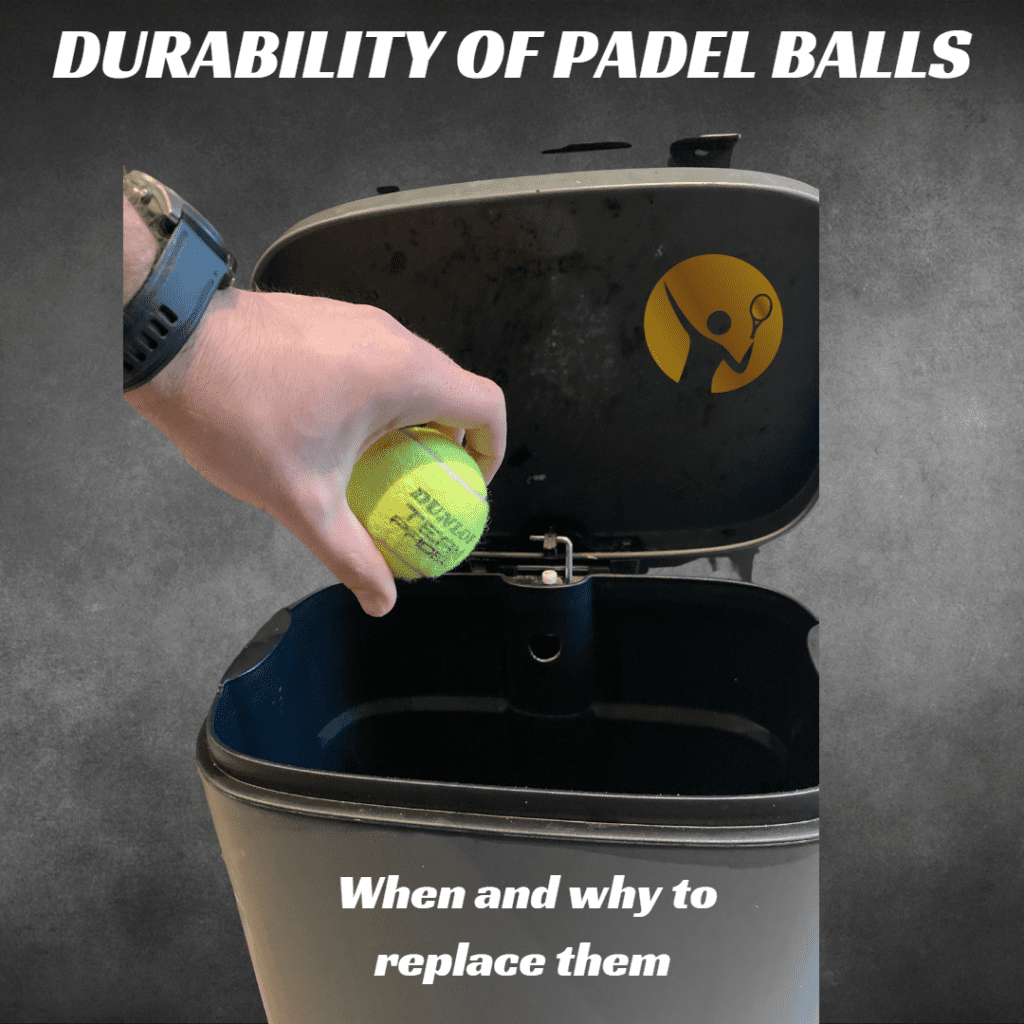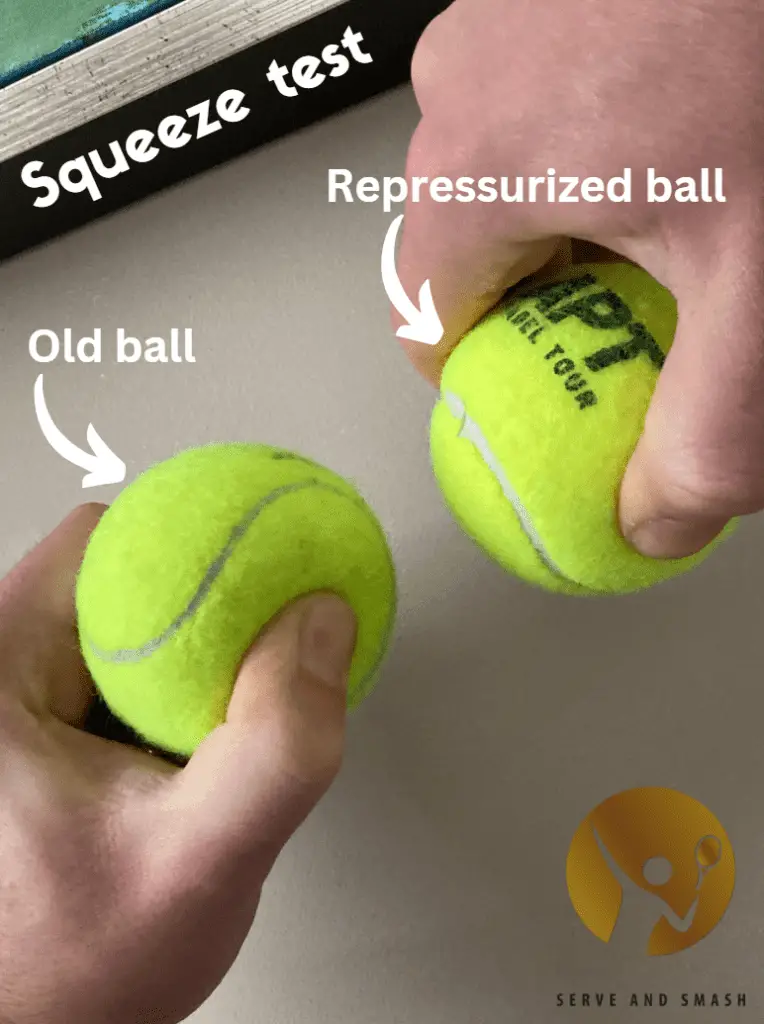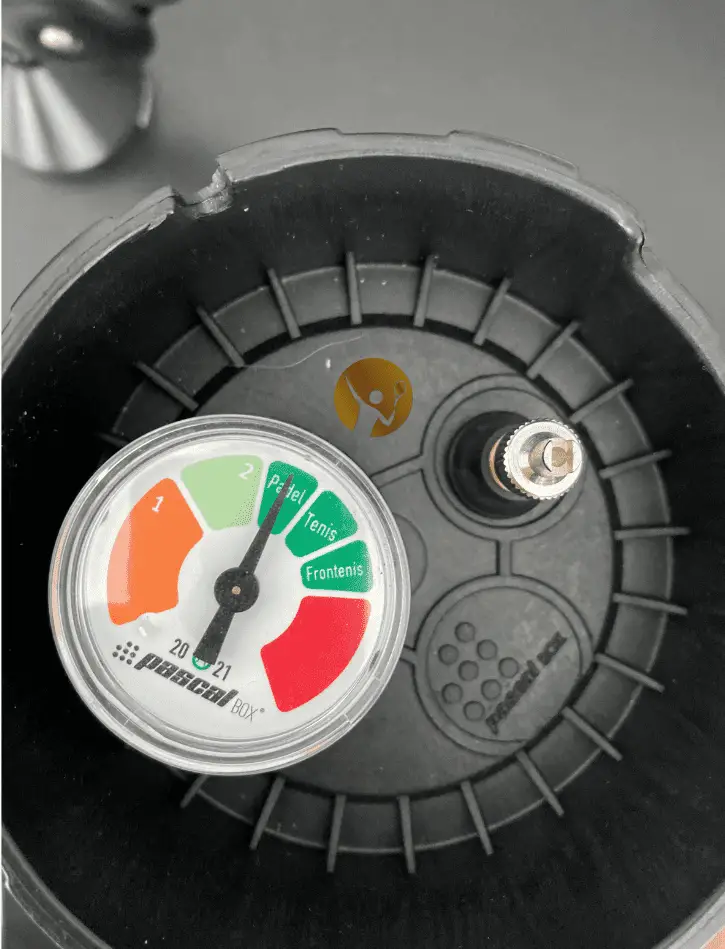This post may contain affiliate links.

While some people seem to play forever with the same balls, others replace them every match. I can already tell you there is a way so you can get all the benefits of new balls without the cost of purchasing new balls every match. But first things first, how long do padel balls typically last?
Overview of topics covered in this article, so feel free to navigate directly if you are looking for only a specific topic of interest :
How Long Do Padel Balls Last?
Padel balls last dozens of matches if pressurized, however, they last only 2-4 games if there are not brought back to regulatory pressure between games. The number of matches depends on the interval between those matches. It may last 4 games if you play all in one week or 2 games in three weeks.
What is all this fuzz about the pressure you might wonder, so let me explain before I will go on to tell you about the expected lifetime of padel balls.
Padel balls (or tennis balls for that matter) lose their internal pressure for two reasons:
- First of all, the balls lose their internal pressure due to exposure to atmospheric pressure (as a result of environmental temperatures). This environmental temperature can be room temperature or any other condition under which you store these balls. Atmospheric pressure is lower than the initial internal pressure of these balls. Therefore as time passes and the balls lose their pressure, ever so slightly, they will ultimately inhibit the same pressure as their environment. Therefore we conclude that balls have lost their pressure.
- The second reason balls lose pressure is upon impact. Every time the ball is impacted it loses some of its internal pressure. If you serve, you let the ball bounce, then hit it and it will bounce at the other end of the court and maybe hits the glass before the opponent returns the ball. You can imagine the ball need to withstand a lot of impacts during a rally, let alone a full padel match.
Noting that pressure loss is a natural consequence of exposure and impact, how does this affect the lifetime of padel balls? The moment you open a new can of padel balls and you hear that magical sound, the clock starts ticking and the balls start to lose their pressure, slowly but steadily. This explains why the interval between the matches is influencing the playability of the balls (assuming you don’t repressure these balls).
If you would check the condition of the ball right after you have played the first match you would not notice much loss of pressure. However, if you play four games during that week you would notice the difference. In this case, the pressure loss is mainly due to the impact (and less due to exposure).
You would also notice a difference if you only play two matches but if those matches are a few weeks apart. In this case, the pressure loss is mainly due to the exposure to atmospheric pressure (and not so much to impact).
However, pressure loss does not mean you cannot use them anymore and thus does not determine how long padel balls last (unless you choose not to repressurize). The main determinant is the condition of the rubber. If the rubber is in good condition it will retain the internal pressure as much as possible. However, if the rubber is in bad condition and possibly cracked, air can slip through the cracks and the balls will lose their internal pressure. In this case repressurizing would not work, since the pressure will be lost upon impact or even immediately when trying to repressurize.
Now we know how long padel balls last, but how do you know when you need to change them?
How Often Should I Replace Padel Balls?
Padel balls should be changed if they have lost pressure. For higher-quality balls, this might be after 2 to 4 matches if you do not repressurize. If you have repressurized the balls between every match, it is likely the balls won’t repressurize after 20 to 30 matches when the rubber is worn out.
While balls that have lost their pressure can still be played with, does that mean it is advised to do so? No, definitely not, at least not if you are serious about your game and your risk of injury.
First of all, it certainly impacts the playability of the balls, since the balls would not bounce as high and it makes the ball and the shots less predictable. If you are serious about progressing, you want to practice your technique. Why practice with balls that behave differently than ones you would play during an actual match? In my estimation, this defeats the purpose of the training and obtaining consistency in your shots. This lack of predictability might catch your opponent by surprise, the same can happen to you.
This additional variability is not even the worst part of it, since players are also more likely to injure themselves as a result of the unpredictable balls. I have seen several players sprain their ankles after stepping on the ball. In order to avoid such accidents myself, I avoid playing with balls that have lost their pressure. This is why I am a big proponent of ball pressurizers, but more on that later, when we go into increasing the lifespan of padel balls.
On top of that, it makes the game slower. While this might sound beneficial, it actually means the ball moves less around the court. And if the ball is not moving as much, guess who needs to move more? Yes, indeed the players, including you!
To summarize why you should change the balls:
- ensure consistent bounces, that will make shots more predictable
- reduces the risk of injury
- better positioning by anticipating the trajectory of the ball
Hopefully, I conveyed the importance of changing padel balls, but I like to make it tangible for you. So if you let me, I will give you practical tips on how you can recognize when it is time to change your padel balls.
How to Actually Recognize When to Replace Padel Balls
Padel balls that can be easily squeezed and those balls with a low bounce are visual signs they need to be replaced. The same holds for imploded balls when they are repressurized in a ball pressurizer. While these are visual cues, some players replace padel balls based on their personal preference.
Let me elaborate on the first and simplest visual sign that signals you need to change your padel balls. If you are using a pressurizing container (also known as a ball pressurizer) you notice that bad or poor-quality balls are imploded. This is the sign to replace your balls. If you want to know what to do with them, then you need to stick around to the end (or navigate directly using the button).
General guidelines on how to tell if you need to change padel balls :
- Squeeze Test : Squeeze the ball and notice how far you can dent it. Below you see the difference, and yeah you need to take my word for it that I squeeze equally hard. A padel ball with sufficient internal pressure can only be dented slightly. Balls that have lost their pressure can be dented further, especially if you use two hands to apply pressure. A rough estimate would be 5% for balls with sufficient internal pressure and 10% for balls that have lost pressure. In case the rubber of the padel balls is cracked, you can often times fully dent them.

- Drop Test : Drop the ball from shoulder height, it should bounce up to just below your hip. If it doesn’t bounce nearly as high, you should change your balls. You can either repressurize (if you have a ball pressurizer at your disposal) or else change the other balls (either repressured or new balls).
Well, you might wonder what the pros are doing. While on an amateur level minor improvements don’t seem to make much of a difference, the professional padel players are looking to optimize every aspect of their game. To avoid any issues with old balls, the professionals play every match with new balls. Or they are just as addicted to the satisfying sound of opening a new can of padel balls.
Although I touched upon this point earlier, it is worth stressing this point. If you don’t pressurize balls then you need to change when they start to become less bouncy, which is usually after 2 to 4 matches. Let’s say you open a fresh can of padel balls and only play the next match a month later, it is likely that the padel balls have lost pressure.
When to change padel balls is sometimes left to personal preference. For example, you might want to use newer balls for your exciting matches to keep you motivated or if you associate the smell of new padel balls with competitive matches. But in the end, it should not matter since if your ball is of the same pressure (thus also not cracked) then the balls should behave similarly. In my experience, it does not matter if you have balls that are a bit frayed as long as the rubber is good. But more on that later.
Considerations to Increase the Lifespan of Padel Balls
Storage conditions including repressuring and using higher quality balls are best practices to increase the lifespan of your padel balls.
While there are visual cues on when to replace your balls, frayed balls are not one of them. Let me explain myself. Rackets with a rough surface are more likely to fray the balls as a result of the extra friction. Although it makes the balls look old, it does not need to decrease the lifespan of the ball itself. Especially if you are using higher-quality balls with good rubber. In that case, it is most likely the internal pressure of the balls is the bottleneck. The big savior here is getting a ball pressurizer.
Personally, I am a huge fan of the Pascal Box pressurizer because you can pump sufficient pressure into the container to get the balls up to the regulatory pressure as defined by the Padel Federation (FIP). You can conveniently get the professional version with sufficient capacity from Amazon if you use the link. Note that it can also be used for tennis balls to get these balls to the regulatory pressure as defined by the Tennis Federation (ITF).
because you can pump sufficient pressure into the container to get the balls up to the regulatory pressure as defined by the Padel Federation (FIP). You can conveniently get the professional version with sufficient capacity from Amazon if you use the link. Note that it can also be used for tennis balls to get these balls to the regulatory pressure as defined by the Tennis Federation (ITF).

The container contains a sealing lid and a manometer on the top, so you know how much pressure you should pump into the pressurizer. While pressure is measured in psi, pound-force per square inch, the manometer shows you the correct pressure for padel, tennis, and front tennis (Spanish racket sport, also known as frontenis). So no need to remember the correct pressure for padel. You use the inflation pump to adjust the pressure in the container. The air will eventually penetrate into the balls resulting in balls that have the appropriate pressure as you would have when you open a new can of padel balls.
Another factor that impacts the durability of padel balls is putting the balls under stress in the form of heavy loads. Whether this can be as something straightforward as stepping on the ball during a match or training session. It can also come in the form of placing any other kind of heavy weight on the balls. Needless to say, the longer the duration the greater the chance it will damage the rubber and therefore your padel balls.
The temperature has an impact on the performance of the balls. In general, padel balls become slower in cold temperatures and low altitudes, and faster in warm temperatures and higher altitudes. Therefore playing with fully pressurized balls (or straight from the can) in the heat, will make the balls as fast as possible. Sure there is also a difference in the type of balls to make them faster or slower. Almost all padel ball manufacturing brands offer at least a fast and slower range of balls.
According to the padel regulations from the International Padel Federation (FIP), there is a difference in the ball that can be used when matches are played more than 500 meters above sea level.
| Factor | How to improve durability |
|---|---|
| Pressure | Repressurize balls between every padel session |
| Storage conditions | Stored dry, cool at or below room temperature, and avoid high variability in temperature |
| Rubber quality | Purchase higher-quality balls that are made of more durable rubber and last longer |
| Load bearing | Avoid stepping on the balls or placing heavy loads on the balls that might cause the rubber to crack |
What to Do with Old Padel Balls : 9 Tips
If you came to the conclusion that it is time to replace your padel balls, then what you might ask? Many people unfortunately just throw away these balls without giving it much thought.
To give you some inspiration, you will find 9 tips below on what to do with old padel balls
- Donate to your local padel club. Many clubs collect these old balls and sell these balls for a small price to companies that recycle these balls into new ones.
- Use it to entertain your pets. Personally, I make my dogs very happy when I decide to use these old padel balls to play with them. Let’s say that they get excited by just seeing my padel bag.
- Decorations. For the more creative minds, I have seen people make Christmas trees or other Christmas decorations of it.
- Key holder. Slightly related to decoration is another use case I did encounter and I thought was very resourcefulness. If you make an incision in the ball you can turn the ball into a holder for your keys.
- Use it as a bumper guard. If decorations are not your thing, then you can cut the balls in half and use them as some kind of bumper to protect. This can be any kind of metal pole you want to protect.
- Fitness landmine attachment. However, I like to use an old padel ball to turn it into a landmine attachment for my barbell. If you are not into fitness, no worries it is not some kind of explosive but it improves the versatility of your barbell to be able to perform more exercises.
- Woodworking tool. The cushioning effect of the rubber and synthetic materials of the padel balls can also help to dampen the effect when you place it on your hammer. This makes it a useful woodworking tool and you can turn your metal hammer into a hammer that is less likely to damage the wood or paint.
- Remove scuff marks. The padel balls can also be used to undo some damage. I’ve seen people use it to remove scuff marks from wooden floors.
- Used as horse arena footing. Old padel balls are ground into rubber crumb that is spread across the equestrian arena where horse owners will train with their horses.

